 The Arkansas is the sixth longest river in America and the second longest tributary to the Mississippi River. Over the course of time in Tulsa it has been polluted then protected both ignored and studied in exhaustive detail. Often slandered, the Arkansas River in Tulsa County now stands as the local challenge of our generation. [Update: City voters approved two low water dams April 5, 2016, but a dam in Sand Springs still awaits funding and is critical to restore the River Corridor in Tulsa County.]
The Arkansas is the sixth longest river in America and the second longest tributary to the Mississippi River. Over the course of time in Tulsa it has been polluted then protected both ignored and studied in exhaustive detail. Often slandered, the Arkansas River in Tulsa County now stands as the local challenge of our generation. [Update: City voters approved two low water dams April 5, 2016, but a dam in Sand Springs still awaits funding and is critical to restore the River Corridor in Tulsa County.]
The Arkansas is a prairie river that, in major part, supports navigation providing substance for the most inland port in America – The Tulsa Port of Catoosa – after it joins as one of three rivers near Muskogee, south of Tulsa. To the northwest of the metropolitan area the Keystone Dam ends Arkansas River’s “wild prairie” phase as the dam controls water releases to prevent flooding and provide hydroelectric power.
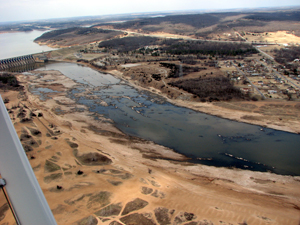 A wild prairie river is a mix of sand and water that braids in ever changing “runs and riffles.” The Keystone Dam prevents downstream migration of sand thus what water flows is now scouring down to bedrock throughout Tulsa County. When rains to the north are frequent, the Arkansas fills from bank to bank, but most often area residents can walk and hop across the river on bedrock without getting their shoes damp. That is not a healthy state for a river.
A wild prairie river is a mix of sand and water that braids in ever changing “runs and riffles.” The Keystone Dam prevents downstream migration of sand thus what water flows is now scouring down to bedrock throughout Tulsa County. When rains to the north are frequent, the Arkansas fills from bank to bank, but most often area residents can walk and hop across the river on bedrock without getting their shoes damp. That is not a healthy state for a river.
Beyond any one public vote, the Arkansas River Corridor Master Plan has been under development for over a decade. The effort has always included close cooperation and communication between Tulsa County, the U.S. Corps of Engineers, the Oklahoma Department of Environmental Quality and other stakeholders.
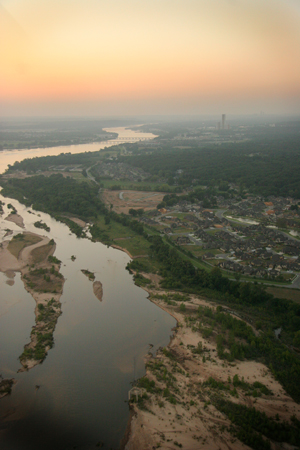 Cynthia Kitchens, Project Manager, US Corps of Engineers Tulsa Regional Office said, “The Arkansas River in Tulsa County is very important to us.”
Cynthia Kitchens, Project Manager, US Corps of Engineers Tulsa Regional Office said, “The Arkansas River in Tulsa County is very important to us.”
Gene Lilly, Water Resource Planner for the Corps said, “There is progress. The Master Plan was developed following Vision 2025 and funded in part by that initiative and by the Corps of Engineers. In 2005 the Master Plan was completed and laid out a connectional plan for the Arkansas River [addressing] flood risk reduction and eco restoration.
“Congress has authorized the Corps to study the Arkansas River in Tulsa County by a specific SMART (Specific, Measurable, Attainable, Risk Informed, Timely) Planning Process, Lilly said adding, “Depending on future funding, we can determine Federal interest in cost sharing of projects.
Lilly said, “The Corps supports the Master Plan’s comprehensive collaborative approach to development. The Master Plan is not our plan, but the community’s plan. We provided some funding, but many ideas came from the public, stakeholders, and community leaders. We will be a part of certain aspects of the Master Plan and an example of that is the current effort on Crow Creek.”
That Crow Creek effort is publicly known as “The Gathering Place” currently underway as a private/public development effort led by the George Kaiser Family Foundation and other corporate and individual donors on the east side of the Arkansas River in midtown Tulsa. Lilly said, “The Gathering Place is an example of taking our concepts to the next level.”
Tulsa County’s most prominent expert on the Arkansas River is Gaylon Pinc, Senior Environmental Program Manager at Program Management Group (PMg) in Tulsa. For over 30 years Pinc was the Manager of Environmental and Engineering Services for the Indian Nations Council of Governments (INCOG) in Tulsa and is a registered professional engineer in Oklahoma, Kansas and Arkansas. Pinc was INCOG’s project manager for the Phase I and Phase II portions of the Arkansas River Corridor Master Plan adopted in 2006. He joined PMg to be Tulsa County’s Program Manager for the continued implementation of Arkansas River projects. Pinc has participated in the intensive planning and feasibility studies.
“In discussions with the Cops in the past we have asked them which projects would be eligible for the $50 million authorized [for Tulsa County by Congress] in the 2007 Water Resources Development Act. The answer is that they didn’t know until the feasibility process has been completed” Pinc said. “The catch-22 was that Tulsa County and the Corps signed the Feasibility Cost Share Agreement, a 50-50 split for a $4 million price tag four years ago, but it required half the costs to come from Federal appropriations not authorizations and we could not front-end with local funds and we never received appropriations after the agreement was in place so that agreement didn’t go anywhere.
“We think the Sand Springs Dam has the greatest opportunity for Federal funds because it provides a large amount of environmental benefit. Specifically, it can store water and release it which helps water quality and that benefit goes downstream impacting the Corridor all the way to the navigation channel. The spacing of the low water dams planned is about eight miles apart. The lakes formed would only be about two miles so you will have much more river bed than created water body.
 “The Zink Dam has limited eligibility for WRDA funding, but is a part of the planning process as the cumulative effects for the Corridor are considered. The Zink Dam [in midtown Tulsa] exists and has a plan for improvement,” Pinc said.
“The Zink Dam has limited eligibility for WRDA funding, but is a part of the planning process as the cumulative effects for the Corridor are considered. The Zink Dam [in midtown Tulsa] exists and has a plan for improvement,” Pinc said.
“What the evaluation will do is make a recommendation on the feasibility for [construction of] the Sand Springs Low Water Dam and the South Tulsa/Jenks Low Water Dam and the Bixby Low Water Dam. Feasibility here is in terms of the benefits and [to determine] if they exceed the cost of construction. We will be looking at the value of the benefits of each of the projects in terms of flood risk reduction, ecosystem restoration and recreation.
“We have construction cost estimates that were developed in previous studies and will be projecting those to today’s dollar. We haven’t yet developed a metric for the value of benefits. For example, if the water quality benefits improve the environment by millions of dollars or defray costs of water treatment required that would be one benefit,” Pinc said.”
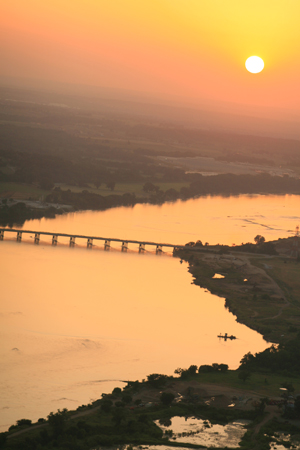 While downstream migration of sand is halted at the Keystone Dam, silt and sand does accumulate naturally and Tulsa County has provided sand moving and Zink Island maintenance over the years.
While downstream migration of sand is halted at the Keystone Dam, silt and sand does accumulate naturally and Tulsa County has provided sand moving and Zink Island maintenance over the years.
Michael Willis, Tulsa County Public Information Officer said, “Construction crews are called on routinely to move sand in and around Zink Lake. Whether the crews are pushing sand onto the island or from the channel to the banks, it costs at least $10,000 in manpower, equipment, fuel and planning. Usually, there is little time to do the job, so the crews plan and execute in short order.”
The plans for low water dams include multiple large gates to move silt and sand providing regular maintenance at lower public cost.
Pinc said, “The management of sand can be done by having enough gates to “sluice” sand downstream during high water. With that you can manage sand accumulations at least close to the dam to avoid clogging up the dam area. That is a much more sustainable method than any mechanical removal.”
Tulsa County Commissioner Karen Keith (District 2) said, “The Arkansas River should be a safe and healthy corridor throughout Tulsa County. It can also be a center of culture, recreation, entertainment and economic opportunity. With the Arkansas River Corridor Master Plan, we have an opportunity to maintain and improve safety while bringing additional opportunities to the region with economic development.”
Some river critics condemn the Arkansas River and any proposal for low water dams from a fear of flooding, but Bill Lawrence, Hydrologist in Charge, Arkansas Red Basin River Forecast Center said, “Tulsa has been very fortunate because the Keystone Dam greatly lowers the risk of flooding within the metropolitan area along the Arkansas River. The risk of flooding in any given year is low, probably less than 10 percent.
Tom Kines, Meteorologist with AccuWeather, a national weather forecasting service said, “A 10 inch rainfall over a 2 day period in the Tulsa area is about a 1 in 100 year event. A 12 inch rainfall over a 3 day period in the Tulsa area is about a 1 in 200 year event.”
In other words, major flooding from the Arkansas River in Tulsa County could happen, but the odds are no greater than a F5 Tornado hitting the city. Should either event occur, low water dams in the Arkansas would be the least of the region’s worries.
Pinc said, “Every time anyone does a flood analysis; the Arkansas River can hold more so we can release more.”
More information on flood control is available online at the U.S. Corps of Engineers, Tulsa Regional Office web site. Information on the environmental health of the Arkansas River in Tulsa is available on the Oklahoma Department of Environmental Quality web site. The documents of the Arkansas River Corridor Master Plan may be found online at http://riverprojectstulsa.info.
So who will fund low water dams on the Arkansas River? Some money was included in the Vision 2025 Tulsa County infrastructure package approved by voters in 2003, but that money mostly allowed for continued studies required by “roughly 25 Federal and State laws that you must adhere to in every detail,” according to Pinc.
“If we still look to Federal funds to build any of the projects, we must focus on the benefit to the ecosystem. There may even be projects we should add that makes the benefit greater,” he suggested.
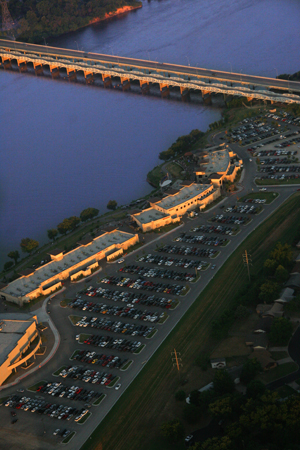 Pinc said, “It is my understanding that there may be excess funds available from Vision 2025 because the bonding companies required a cash reserve. As the bonds are paid and assuming that the economy remains stable, all cash reserves return and are available for public expense. That may be as large as $40 million, but that number is still an estimate at this time. Assuming the program does not need to dip into the reserve to make final debt payments through 2016, that money would be available. Then the original authority would distribute those funds by a public methodology.
Pinc said, “It is my understanding that there may be excess funds available from Vision 2025 because the bonding companies required a cash reserve. As the bonds are paid and assuming that the economy remains stable, all cash reserves return and are available for public expense. That may be as large as $40 million, but that number is still an estimate at this time. Assuming the program does not need to dip into the reserve to make final debt payments through 2016, that money would be available. Then the original authority would distribute those funds by a public methodology.
“Looking with the benefit of hindsight, whoever proposes a project should have a budget that is adequate to build the project. In Vision 2025, four [Arkansas River] projects were funded at a total of $9.6 million. For sediment management, for example, there was enough money to dig a hole [for sand to fall into], but not to dredge perpetually. Shoreline beatification without habitat restoration or bank stabilization might have been adequate, but $5.6 million for two new low water dams is not enough money no matter how much match officials hoped to find. The best match programs we have found to date are 75 percent Federal to 25 percent local and that is with direct flood control benefits,” Pinc said.
“Zink Dam when it was built in the 80s cost over $8 million and that was without the pedestrian bridge and with inadequate gates. New dams twenty years later if anyone had worked up a budget would have been likely $25 million each, but [River Park Officials at that time] based their request on the original un-inflated cost of Zink Dam. From the beginning the budget was inadequate to build one, say nothing about two, dams.
“We have been able to leverage Federal funds to continue the process with some Vision money, but we will never be able to leverage enough Federal funds for any match that exists today to build even one dam. We received enough money in Vision 2025 to go through the regulatory permitting and design stages to get us ready for construction, but not to build.
Pinc continued, “One of the things we heard from the opposition to the 2007 River Vote was that we didn’t then have the permits and, they alleged, we would never get them. Well, at that time we were not even close to asking for a permit – we were still doing the environmental data collection Federal Law requires. We were just getting ready to do the design to work on the permitting when that went to vote. While the Corps has been involved at every stage, the opposition railed they would never provide a permit.
“Now we have a 404 permit in hand to do the Zink Dam work so, yes, we can get permits to build low water dams on the Arkansas River in Tulsa County. All of the work we are doing is for the purpose of securing permits to build. The Arkansas River is a protected river with endangered species and you have to do a tremendous amount of design work and environmental studies.
“Low water dams are not getting less expensive to build and the current estimates are around $60 million for Sand Springs, $50 million for South Tulsa/Jenks, $41 million for Zink and $31 million at Bixby. Who can spend that kind of money? No developer will build them because there is no profit or return on that investment unless they control the whole river and charge for its use. The low water dams are rightly public infrastructure,” Pinc said.
 So who is advancing a River package for local voters to fund the Arkansas River Corridor Master Plan’s implementation?
So who is advancing a River package for local voters to fund the Arkansas River Corridor Master Plan’s implementation?
Pinc said, “No one to my knowledge is working on that. Our local voters have been presented two wonderful local packages to fund prominent river projects and rejected both. It still amazes me that that voters rejected the 2007 River Vote with an immediate 25 percent return on their investment with $100 million plus amenities from private sources to make the river a destination with fun things to do.
“Just like the BOK Center is not just for the City of Tulsa, the Arkansas River could be a destination for people throughout the region. Not everyone enjoys concerts. Not everyone will enjoy the River, but to have an attractive, healthy, functionally fun river in the center of Tulsa County is a community enhancement long overdue,” Pinc added.
Tulsa County Commissioner Ron Peters (District 1) said, “A healthy Arkansas River is one of the keys to economic growth for Tulsa and all of the communities along its path. I am convinced that additional private development will happen along the river when the public infrastructure is improved to make it possible.”
Commissioner Peters’ position was dramatically validated October 15, 2013 as the Muscogee (Creek) Nation broke ground on a new entertainment venue on the Arkansas River. It is a $335 million investment. Once finished, the new venue will generate approximately 800 jobs and have an annual economic impact of $135 million.
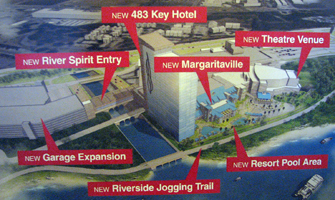 “The nation made a decision 10 years ago to make a significant investment in the banks of the Arkansas in Tulsa,” Principal Chief George Tiger said at the ground breaking event.
“The nation made a decision 10 years ago to make a significant investment in the banks of the Arkansas in Tulsa,” Principal Chief George Tiger said at the ground breaking event.
John Cohlan, CEO of Margaritaville, the operating company for the new facility, told Tulsa Mayor Dewey Bartlett publicly at the event he hopes the development along the Arkansas River in south Tulsa can lead to getting more water in the river.
 “If this isn’t a brilliant PR campaign by the Muscogee (Creek) Nation to bring water to the river, I don’t know what would be,” Cohlan said.
“If this isn’t a brilliant PR campaign by the Muscogee (Creek) Nation to bring water to the river, I don’t know what would be,” Cohlan said.
Mayor Bartlett promised water in the Arkansas River and encouraged other businesses to take advantage of Tulsa’s 11 miles of shoreline.
However, the Arkansas River was not included within the infrastructure package the City of Tulsa offered voters November 12, 2013 at near a billion dollars. Structured by the Tulsa City Council it is remarkable that City Councilor G. T. Bynum recently told a 76-member contingent of Tulsa-area city and business leaders during a recent visit to developed riverfronts in Pittsburgh, “I’m fired up, charged up, ready to go already scheduling meetings for when we get back to talk about how we can really start focusing on bringing forward to the public a proposal to build those (low-water) dams.”
 An independent group of citizens have established a Facebook page by the name Tulsa River Advocates, “To promote the beauty, safety and prosperity of the Arkansas River in Tulsa County. Not affiliated with any government, business, or development, but eager to work with all to see the Arkansas River Corridor Master Plan implemented” the public page notes.
An independent group of citizens have established a Facebook page by the name Tulsa River Advocates, “To promote the beauty, safety and prosperity of the Arkansas River in Tulsa County. Not affiliated with any government, business, or development, but eager to work with all to see the Arkansas River Corridor Master Plan implemented” the public page notes.
One Advocate organizer requesting anonymity said, “We will not fail to communicate the importance and immediate need for Arkansas River development. Some of our members believe previous votes failed because officials were not aggressive enough in answering critics. We will not be so restricted. We will not fail to make the public case or waste another generation waiting for water in the River.”

